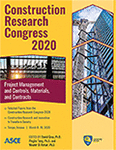Construction Research Congress 2020
Assessing the Impact of Utilizing Building Information Modeling on Alternative Project Delivery Method Projects
Publication: Construction Research Congress 2020: Project Management and Controls, Materials, and Contracts
ABSTRACT
Alternative project delivery methods (APDM) have emerged as a result of increasing project complexity, the need for fasted project delivery, and the benefits of stakeholder integration in the construction industry. APDM require rigorous collaborative effort to get information adequately flowing between project stakeholders to maximize the potential benefits. Innovative technologies such as building information modeling (BIM) were developed in part to cater to information communication challenges. However, there is a need to understand the impact of BIM on APDM projects, and how both can be used jointly to improve the overall delivery of a project. This research was conducted by collecting secondary-data through reviewing case studies of 15 completed APDM projects that have utilized BIM. The benefit reported with the highest frequency was visualization and simulation. The drawback reported with the highest frequency was software/technological issues. The sample size of this study may not be representative of the construction industry as a whole; however, this study serves as a valuable starting point for future research that may be conducted on this topic. The main contribution of this exploratory study is the identification of 20 distinctive key benefits and four drawbacks for the application of BIM on APDM projects.
Get full access to this article
View all available purchase options and get full access to this chapter.
REFERENCES
American Institute of Architects (AIA) (2010). “Integrated project delivery: case studies.” American Institute of Architects. Washington, D.C.
AutoDesk. (2012). “Case study: balfour beatty. AutoDesk.” AutoDesk, <https://www.autodesk.com/case-studies/balfour-beatty-construction-omni-dallas-hotel> (Nov. 10, 2018).
Becerik-Geber, B., and Kent, D. (2010). “Implementation of integrated project delivery and building information modeling on a small commercial project.” Associated Schools of Construction Annual International and CIB Workgroup 89, Wentworth Institute of Technology, Boston, MA.
BIM in New Zealand (BIMNZ). (2014). “Case study: kathleen kilgour centre.” <https://static1.squarespace.com/static/57390d2c8259b53089bcf066/t/58111aeb6a4963b5eef7103f/1477516021134/3+BIMinNZ+Case+Study+KathleenKilgour> (Nov. 15, 2018).
BIM in New Zealand (BIMNZ). (2017). “Case study: christ church justice & emergency services precinct.” <https://static1.squarespace.com/static/57390d2c8259b53089bcf066/t/5a124ea00d929777957f58c2/1511149230448/BIMinNZ+-+Case+Study+-+Chch+Justice+-+new+Nov+2017.pdf> (Nov. 15, 2018).
Bottari, A., Ioudioux, G., Mancini, M., Travaglini, A. (2016). “Guidelines for building information modeling (BIM) performance improvement in the EPC industry.” 2016 International Conference on Industrial Engineering and Engineering Management.
Caballero, A. (2017). “39 Victoria Street, London – Willmott Dixon’s inside job for department of health.” Chartered Institute of Building, <http://www.bimplus.co.uk/projects/willmott-dixons-inside-job-doh> (Nov. 10, 2018).
Constructing Excellence in the Built Environment (CEBE). (2010). “Welcome trust sanger institute.” CEBE, <http://constructingexcellence.org.uk/wp-content/uploads/2014/10/CASESTUDY_WELLCOME_web.pdf> (Nov. 15, 2018).
Dodge Data and Analytics (DDA). (2018). “The business value of BIM for water projects.” Smart Market Report, <https://www.awwa.org/Portals/0/files/resources/water%20knowledge/rc%20asset%20management/BusinessValueofBIMforWaterProjectsSMRFinal.pdf> (Nov. 15, 2018).
Doumbouya, L., Gao, G., and Guan, C. (2016). “Adoption of the building information modeling (BIM) for construction project effectiveness: The Review of BIM Benefits.” American Journal of Civil Engineering and Architecture, 4(3), 74-79.
Dowsett, R. M., and Harty, C. F. (2013). “Evaluating the benefits of BIM for sustainable design: a review.” 29th Annual ARCOM Conference, Reading, UK, 13-23.
Francom, T., and El Asmar, M. (2015) “Project quality and change performance differences associated with the use of building information modeling in design and construction projects: univariate and multivariate analyses.” Journal of Construction Engineering and Management, 141(9), 04015028-1– 04015028-9.
Hanna, A., El Asmar, M., and Boodai, F. (2013). “State of practice of building information modeling in mechanical and electrical construction industries.” Journal of Construction Engineering Management, 139(10), 04013009.
Lindbald, H. (2013). “Study of the implementation process of BIM in construction projects.” Masters Thesis, KTH Royal Institute of Technology in Stockholm, Stockholm, Sweden.
Ma, C., Li, X., and Meng, Y. (2014). “Study on the application of BIM technology in construction projects under IPD mode.” International Conference on Construction and Real Estate Management, Kunming, China, 229–236.
U.S. National BIM Standard (2007), National building information modeling standard part-1: overview. principles and methodologies: us national institute of building sciences facilities information council, BIM Committee.
Roe, P., Hielema, E., and Knutson, G. (2013). “Collaborative project delivery for the 21st century: combining construction manager at risk implementation with BIM.” WEF Annual Technical Exhibition and Conference 2013, Chicago, IL.
Sebastian, R. (2011). “Changing roles of the clients, architects, and contractors through BIM.” Engineering, Construction and Architectural Management, 18 (2), 176-187.
Scottish Futures Trust (SFT). (2018). “BIM case studies: inverness royal academy.” Scottish Future Trust, <https://www.scottishfuturestrust.org.uk/storage/uploads/casestudyinvernessmay2018> (Nov. 10, 2018).
Succar, B. (2009). “Building information modeling framework: a research and delivery foundation for industry stakeholders.” Automation in Construction, 18 (3), 357-375.
Terreno, S., Anumba, C., Gannon, E., and Dubler, E. (2015). “The benefits of BIM integration with facilities management: a preliminary case study.” 2015 International Workshop on Computing in Civil Engineering, Austin, TX.
Worden, K. (2016). “BIM and communication: implementation of BIM into an IPD contract to encourage project teams to communicate.” Masters Thesis, California Polytechnic State University, San Luis Obispo, CA.
Worthing (2015). “Building information modeling pilot project. Meadow Road Affordable Housing Scheme.” Worthing Homes, <http://archive.secbe.org.uk/> (Nov. 10, 2018).
Yan, H., and Demian, P. (2008). “Benefits and barriers of building information modeling.” 12th International Conference on Computing in Civil and Building Engineering, Beijing, China.
Zuh, A., BA, T., and Chixong, J. (2016). “BIM based design management of a building project collaboratively designed with a foreign design firm in China: a case study.” International Journal of 3-D Information Modeling, 5(2), 16-38.
Information & Authors
Information
Published In
Construction Research Congress 2020: Project Management and Controls, Materials, and Contracts
Pages: 1073 - 1080
Editors: David Grau, Ph.D., Arizona State University, Pingbo Tang, Ph.D., Arizona State University, and Mounir El Asmar, Ph.D., Arizona State University
ISBN (Online): 978-0-7844-8288-9
Copyright
© 2020 American Society of Civil Engineers.
History
Published online: Nov 9, 2020
Published in print: Nov 9, 2020
Authors
Metrics & Citations
Metrics
Citations
Download citation
If you have the appropriate software installed, you can download article citation data to the citation manager of your choice. Simply select your manager software from the list below and click Download.
